Ceci fait suite à "Les vieux soldats ne meurent jamais" mis en ligne le 22 février 2017.
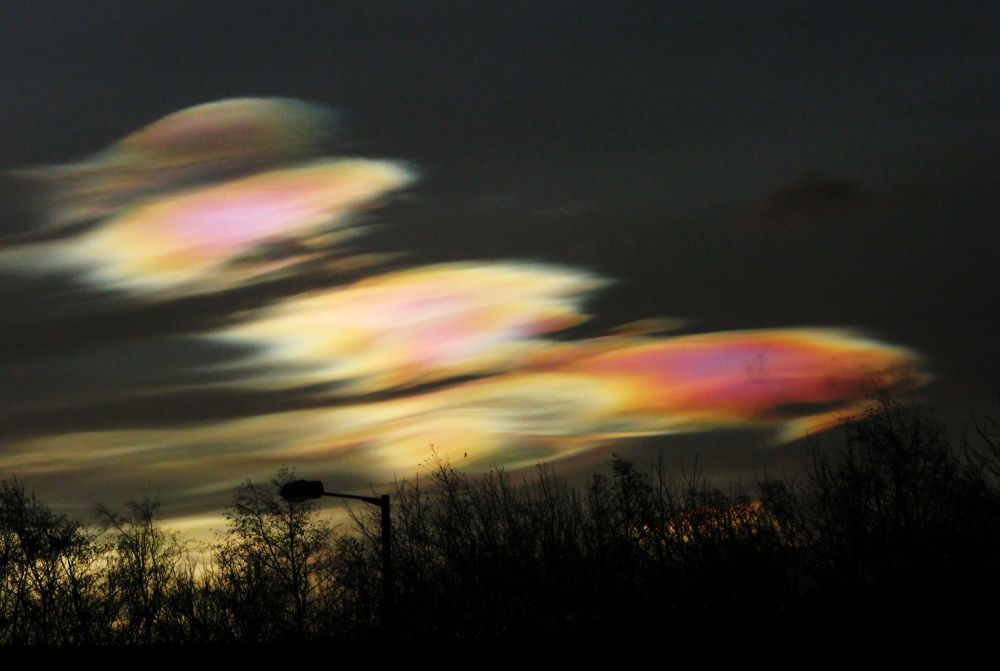
The planet Refuge, home of the enigmatic cloud-whales. Vast aerial creatures created by an unknown species, the telepathic whales are far more than uniquely beautiful. Their thoughts and dreams manifest, falling from the sky to form vast reefs of solid data comprised of pure, retrievable thought. Dreamfall. Joan Vinge. New York: Warner Books, 1996.
MOBYDICKANA. Troupeaux étoilés du firmament marin : les cailloux ne sont jamais semés au hasard, par delà les temps.
Jesus, the Redeemer, was Cetus, Leviathan. And all the Christians all his little fishes. D.H. Lawrence. Studies in Classic American Literature. Penguin Books, USA: 1923. p. 170 .
RAPPEL INTRODUCTIF.
1. Le roman MOBY DICK, d'Herman Melville (1851) est structuré comme un song line aborigène, un récit du temps du Rêve. Voir Emmanuel Lézy. "La saison et la ligne ou Moby Dick, une leçon de géographie métisse."
http://revel.unice.fr/cycnos/?id=1645
2. Son thème principal est la "première guerre du Pacifique", qui opposa des cachalots aux baleiniers pendant quatre décennies à partir de 1820, que l'auteur symbolise à travers son épisode décisif ("Une révolution bleue" mis en ligne le 13 février 2017, "Les vieux soldats ne meurent jamais" mis en ligne le 22 du même mois), dont l'auteur put toucher le caractère et la dimension à travers les récits des marins qui furent ses compagnons pendant cinq ans et demi, de mai 1839 à octobre 1844, à bord de différents navires dont 3 baleiniers et lors de séjours dans des îles du Pacifique... Or, le Rêve n'est ni un passé remémoré ni un présent rétroactif, mais une expression de l'éternité avérée dans l'espace, un cadre invisible du cosmos (Philippe Descola. Par - delà nature et culture. 2005. NRF, Gallimard).
3. Son personnage principal est l'armée des cachalots, que l'auteur symbolise à travers son général en chef. Ce personnage est lui - même un être du rêve, qui ne peut être assimilé à un classique héros mythique, puisque son élan ordonnateur s'est poursuivi sans interruption après qu'il eut abandonné la surface de la Terre (Descola 2005, déjà cité).
"... pendant un instant tout son corps de marbre forma une haute arche, comme le pont naturel de Virginie, et en avertissement, agitant sa queue - bannière en l'air, le grand Dieu se révéla, plongea et disparut." MOBY DICK ch. 133 "La chasse - Premier jour". Illustration de Matt Kish.
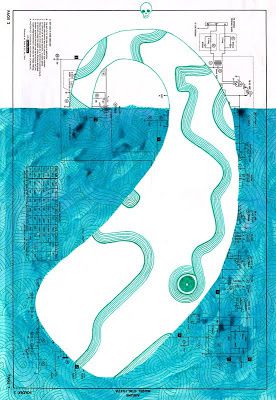
MYRIADES AUSTRALIENNES. Depuis des dizaines de milliers d'années, de nombreuses communautés aborigènes associent baleine et serpent arc - en - ciel, à la fois entité vivante et itinéraire, encapsulant l'espace et le temps.

Le dialogue entre humains et cétacés est régulier, avec les baleines blanches (des espèces baleine à bosse et baleine franche australe notamment) comme interlocuteurs privilégiés.
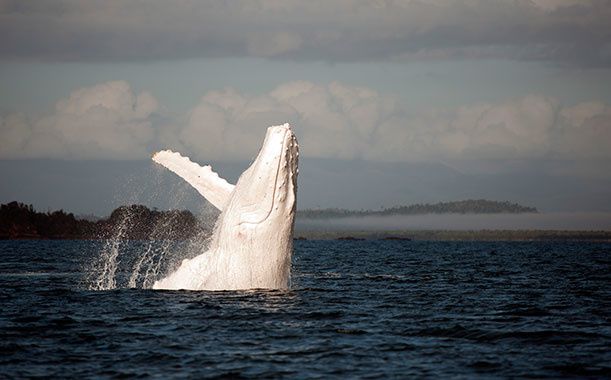
Voir : Jason Cressey (Vancouver, Canada). Rapa Nui Journal, September 1998, 12 (3), 75 – 84.
http://islandheritage.org/wordpress/wp-content/uploads/2010/06/RNJ_12_3_Cressey.pdf
The most sacred site of the Miming and Kondoledjeri ('Whale People') of South Australia correspond remarkably closely to the preferred coastal locations for the Southern Right Whales to breed, play and give birth.
To both of these tribes, the whales (especially any rare, all-white whales) are sacred, and the Elders still relate stories about Numbadda (the Rainbow Serpent), which they symbolize as a whale. These people have long possessed the ability to 'call' the whales close to shore to watch them cavorting in the waves. Small groups of tribal Elders would go to Numbadda's sacred sites at midday, where they would be sprayed with the mist of the ocean as the waves crashed against the rocks and up through small openings. This spray created a rainbow as it refracted the sunlight. reminding the members of the tribe of their connection with the Rainbow Serpent. The Elders then went to a special site on the top of a nearby cliff, where they would sing to the whales. They beckoned the mighty leviathans to come close to shore, which the whales invariably did, and the Elders would pay respect to their totemic guardians in the sea below. The Kondoledjeri people also speak of a particular Whale Dreaming site which is the home of all 'whale souls' and to which the spirits of all whales travel when the physical body dies.
LES 7 BALEINES NEO - ZELANDAISES. Le même Jason Cressey évoque également une légende maorie où 7 grands cétacés dialoguent avec la faune marine, chacune d'entre elles ayant son propre nom et ses interlocuteurs particuliers. One popular Maori story tells of mighty whales that did not enjoy a life playing in the waters or helping troubled seafarers. In the village of Kereheretau there lived a very powerful, though ill-tempered, medicine man who had seven huge whales in his care. He would send the whales out each day to gain news about the world and happenings far away. The first whale, Tahutoria, gathered information from other whales about distant tribe and other lands. The second whale, Takitaki, spoke with the dolphins, and heard of their ocean adventures and the canoes they encountered on their journeys. The third whale, Korito, communicated with sharks, who spoke of distant battles and bloodshed. The fourth whale, Onepoto, conversed with the swordfish and flying fish about the magic of the clear blue ocean realms, while the fifth whale, Witea, learned of the depths of the dark ocean from the groper fish (Achoerodus).The sixth whale, Tuhara, heard of strange, exotic creatures in distant seas from the snapper, while Hikunui, the youngest and smallest of the seven whales, stayed close to shore, chatting with the stingrays.
L'ARMEE PAN OCEANIQUE. La mythologie maorie fait état d'un cachalot géant qui commande à tous les cétacés, guide une armée de ceux ci et accompagne les canoes maoris dans leur grande migration transpacifique au XIVème siècle. A taniwha from the folklore of the native people of New – Zealand, the Tautira – Kauika was a fairy animal, a sperm whale said to accompany the hero « Takitimu » (both sacred canoe and captain in his voyage from western Pacific to the island Aotearoa). Tautara – Kauika was the chief of all the whales (of all species?) in the oceans and commanded a large army of them. Sources : Cowan, Tales of the maori, 33 – 34 ; Orbell, Concise encyclopedia of maori myth and legend, 195. In : Teresa Bane. 2015. Encyclopedia of beasts and monsters in myth, legend and folklore. Mc farland and Company publishers, Jefferson, North Carolina.
LE POISSON - BALEINE SLAVE. En mer d'Azov, ce "poisson géant" transporte sur son dos la communauté slave archétypale (voir "Retour dans la Mère Patrie" mis en ligne le 24 mars 2016).
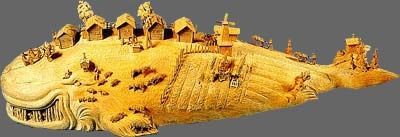
Et dans les représentations des anciens scandinaves, certaines baleines sont grandes comme des îles et leur dos est végétalisé, d'autres protègent les navires (voir "Culture glaciaire" à venir sur ce blog le 1er mai prochain).
Dans son "Men and Whales", Pequot Press 1999 (chapitre "Chinese whaling") Richard Ellis indique que : les chinois chassent les baleines avec efficacité dans le Hainan (mer de Chine), dans la deuxième moitié du premier millénaire. Les Song font le commerce de l'ambre gris dans toute la région. Cette substance est, à leurs yeux, la salive crachée par un dragon océanique... Leur premier contact référencé avec les îles philippines date de 982. Dans la première moitié du XVème siècle, l'immense flotte Ming de l'Amiral Zheng He explore la région jusqu'à l'Australie occidentale et l'océan indien jusqu'à l'Afrique orientale. From 1405 to 1434, the Ming ships visited the Philippines, Indochina, Sumatra, Java, the East Indies, Ceylon, (Western Australia) and perhaps even the Red Sea (oriental Africa). Of course there are whales in these waters, but references to their capture are few.
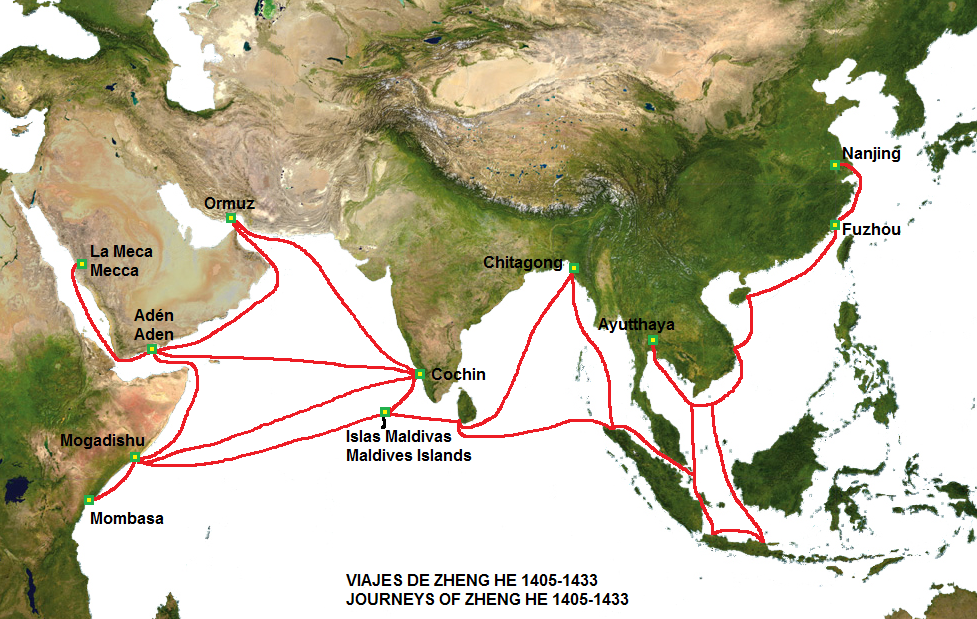
XVIIème - XXème siècles : LES 10 MOBY DICK.
VERTIGE ("un sentiment océanique de profusion"). Frappant l'esprit par son immensité, la baleine est perçue par les communautés côtières japonaises comme plus grande encore qu'elle n'est en réalité. Divinité des abysses exilée par un séisme, elle est ici représentée avec un globe oculaire aussi volumineux qu'un homme.
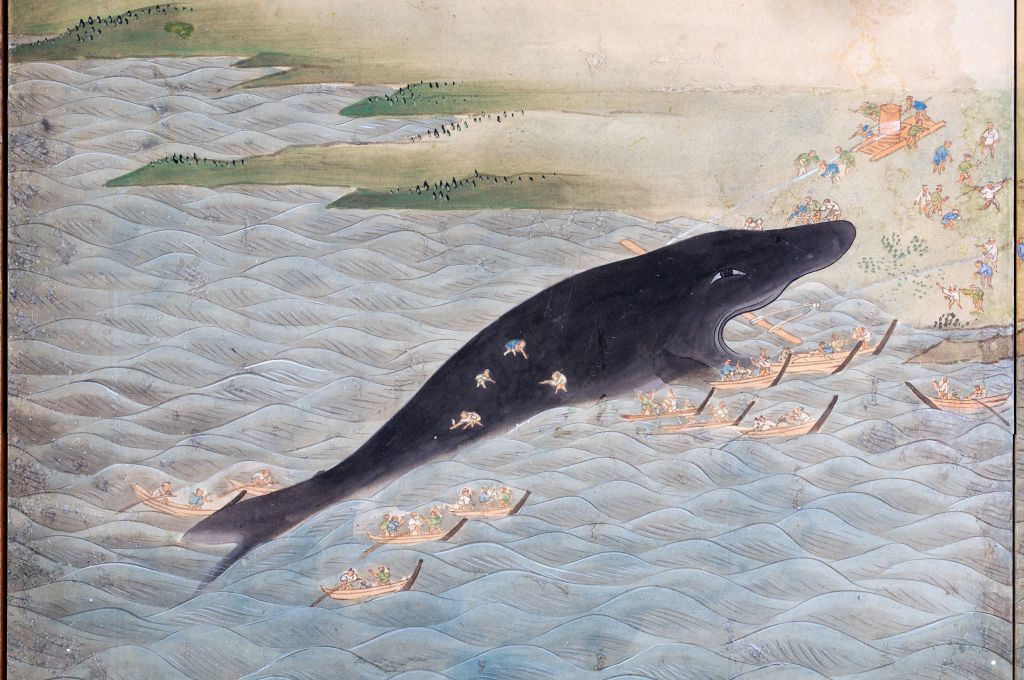
LES JUMEAUX NIPPONS. Une très ancienne légende évoque un navire sauvé de la tempête par deux grandes baleines blanches, puis l'abandon consécutif de la consommation de viande des animaux de leur espèce par la communauté des rescapés:
https://hyakumonogatari.com/2013/05/10/bakekujira-and-japans-whale-cults/
In Miyagi prefecture, Kesenmema city, Karakuwa town , a legend is told of a ship foundering in the storm that was approached by two massive, white whales. The two whales swam to either side of the ship and steadied it, guiding it into port before sailing away. From that day forward, the citizens of Karakuwa down abandoned their ancient custom of whale eating.
A partir de la deuxième moitié du XVIème siècle, la mise en place de filets géants pour la capture de troupeaux entiers de cétacés de diverses espèces (voir l'illustration ci - dessous) va influer sensiblement sur les habitudes et la psychologie des proies, avec des conséquences sur l'arc Pacifique dans son ensemble.
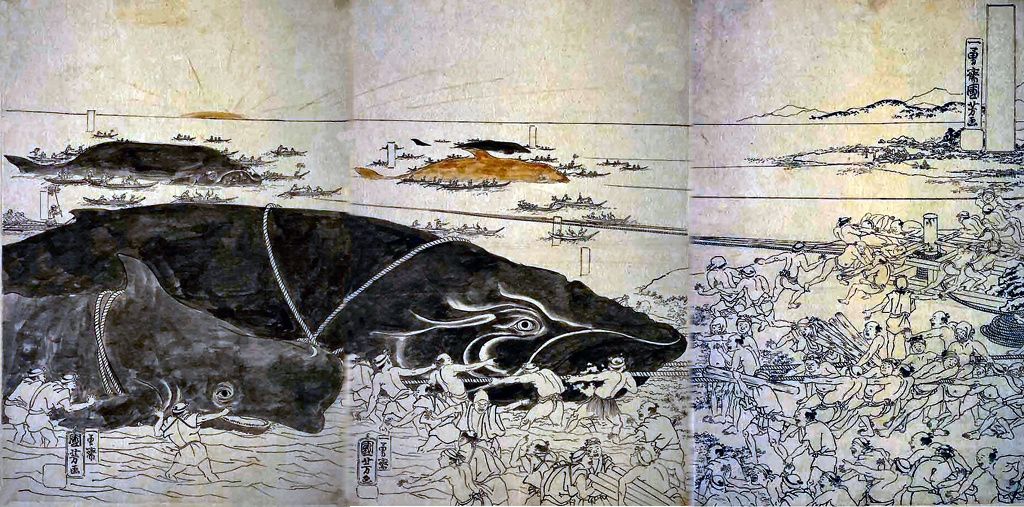
LES PROTECTEURS DE NAVIRE SONT AUSSI INDONESIENS. Eric M. Keen, dans son substantiel rapport de 180 pages publié en 2011, raconte comment de grands cachalots blancs sont considérés comme des puissances tutélaires et protectrices par des chasseurs de cet animal dans certaines petites îles de la Sonde orientale, en particulier, les membres de la communauté de LAMALERA, village qu'il présente comme un authentique New Bedford australasien, à la fois plus ancien et plus pérenne que son équivalent américain lié au capitalisme et la mondialisation.
"If Melville were alive today and seeking a muse to inspire the opus that would eventually become Moby Dick, Lamalera – not New Bedford, nor any American town for that matter – would be the only community out there still up to the challenge"...
Les habitants y pratiquent cette chasse particulière depuis de nombreuses centaines d'années les portugais mentionnaient le fait au XVIème siècle), alors même qu'ils font bénéficier les baleines à fanons d'un tabou strict. Comme les "jumeaux nippons", les cachalots blancs des petites îles de la Sonde orientale protègent les embarcations et veillent même à la qualité de leur conception, quitte à les détruire quand ils constatent que celle - ci laisse à désirer...
https://emkeendotorg.files.wordpress.com/2016/11/9266215_asd_ust_draft7_20110921_final.pdf
At surface dwell. Lessons from Lamalera and its whales, by Eric M. Keen.
Le Pape des poissons. The name for the sperm whale in Bahasa Indonesia, “ikan paus,” transliterates to “Pope of the fish.” Indeed. Here we have a linguistic tribute to this glorious species -- His Imminence, the Papacy of the Deep – a reverence for whales that I have not seen manifest in many other languages.
Bapak Rufinus Karaf, a senior boatman who had been a lama fa for over forty years, was interviewed by BBC as the crew was sailing out to the hunting grounds: "[One time, long ago,] I saw a white whale...When the white whale is seen, we are not allowed to catch anything...the white whale is an ancestor. When the white whale appears sometimes he swims around the boat, and he is checking the construction of the boat....but if there is something wrong...like the wooden nails are placed incorrectly, then he will strike the boat and bring down that place."
Later in the production, the village sail-maker told his story about the “ikan paus putih” as he sat cross-legged in the sand weaving together palm fronds:
A shinto – like reality. "The white whale came to watch and swam around us. Sometimes he appeared, sometimes he dived. When he is close...he doesn't like to come to the surface. He doesn't always appear, only very rarely. But when he does appear, he always swims around, as if to protect...the white whale takes control. When we've caught a sperm whale, the white whale follows, or accompanies us."
Voir aussi : In Search of Moby Dick: The Quest for the White Whale, Tim Severin. Basic Books, 2000.
"The centerpiece of the book is a visit to the little-known island of Lamarala, the 'last community on earth where men still regularly hunt sperm whales by hand.' An old-timer with 60 years of whaling notched into his harpoon explains enthusiastically that the white whale 'has visited us many times. Sometimes it can be a wicked fellow.' (Eric Keen s'interroge - voir plus bas - sur le caractère importé ou endogène du "vengeful albino"...). "But when he appears, that means he is angry...He never comes to the surface, like the other sperm whales...to this day, they have never killed him. Around 1970...we got into an accident with the white whale when it attacked our boat...the white whale suddenly struck beneath our boat, and the boat was turned upside down, and all the crew were swimming, as occasionally happens..."
Nous n'avons à ce jour aucune donnée concernant des baleines blanches protectrices des bateaux chez les communautés côtières des Philippines, du Vietnam, de Tai - Wan, de Corée, et de Chine (Hainan). Celles - ci ayant des rapports très anciens et très étroits avec les cétacés, comme leurs voisins indonésiens et japonais, il est tout à fait possible que des recherches plus systématiques et approfondies mettent en lumière de tels récits, notamment en fonction de ce qui va être établi dans ce qui suit.
TIMOR TOM, depuis la nuit des temps. Ce cachalot combattant salué par Melville ("Les vieux soldats ne meurent jamais" du 22 février dernier) n'est donc peut - être qu'un représentant d'une très ancienne dynastie cétacéenne, qui jouait auprès des cachalotiers de Lamalera un rôle analogue à celui du Bison Blanc pour les indiens des plaines...
Il occupa une place de choix dans les récits pour le moins folkloriques d'un harponneur anglais d'Ipswich (Suffolk), particulièrement réputé, Bully Sprague, qui aimait à se présenter comme un moderne Jonas : celui - ci situe son aventure lors du dernier voyage du baleinier anglais "Anaconda", à bord duquel il avait servi pendant de nombreuses années en tant que second du capitaine Sartori (s'agissait - il bien du Timor Tom des années 1800?) : "Down off Timor, Captain Sartori laid me on to an all-fired big bull-whale. Soon as I stood up I knew it was Timor Tom I was on. He was grizzly and white; his hide scarred an' furrowed, and old irons stood out of his white hump like stubbs in a corn-field in snow-time. I was gallied some when I saw his white back, but I couldn't help hitting him, you know, from long habit; so I added two irons to the score in his back. "'Just as quick as winkin', his old jaw came up and cut the bow right off at the bow-thwart, an' we two (that is, the bow and me) went a-kiting, I tell you! When I turned to come down, there was the whale end up, mouth wide open, waitin' for me; his throat looked like a whitewashed cellar door, but I saw his teeth were smooth with the gum, an' I took some comfort in that. When I struck his throat, he snapped for me, but I had good headway on, and was splashed against the soft bottom of his stomach, when I heard his old jaws come together with a noise like the flap of a maintop-sail in a gale before the ear-ring is hauled out. I was pretty much tuckered out for want of breath for a little while, an' l sot down on the sou'-east corner of his liver, and swung my legs York fashion, while I got my wits aboard. It wasn't at all dark down there, for there was ten thousand of them little shining sea-jellies, stickin' all around in the wrinkles of his stomach, and there was plenty of room, too. Bymeby I got easier, an' kind o' accepted the situation, when I saw a black patch on the starboard side of the stomach well forrard, and I walked over to see what it might mean. I picked out a jelly-fish bright enough to light a pipe a'most, and held it up, and I saw pricked in Injey-ink, in great big printin' letters, "JONAH. B.C. 1683." Then I knew just where I was, and began to feel real bad. I remembered how my old mother used to read that story to me when I was a babby, to turn me agin' whalin', and how I used to tell her that harpoons weren't invented in them days. I kind o' felt as if a judgment had come on me, and I took a fresh quid for consolation sake. I saw at once that Timor Tom warn't used to tobacco, for a kind o' turnin' of the stomach began. So I picked up a jackknife I saw layin' on the floor, and hacked a big plug all into little bits, and slipped 'em into hundreds of little poutin' mouths in the stomach, that I saw a-gapin' at me. The physic worked to a charm. The whale began heavin' an' squirmin' real awful, when, all at once, the stomach turned clean over with a flop like an earthquake, and I was shot out with about a cart-load of chawed squid that laid around the floor. The mate's boat was then pickin' up Captain Sartori and the crew, and they took me in too. When I told them about the printin', they laughed right out; but when, I showed them the horn-handled jackknife, and they saw Jonah's initial on one side and a picter of the American eagle on the other, why, they believed my story. Just then I heard some one yell down the companion-way, "Watch ahoy! turn out; eight bells." Then I knowed I'd been a-dreamin' an all-fired lie of about forty nightmare power.' And that's Bully Sprague's story of Jonah's whale." Pages 352 - 354, dans "Nimrod of the sea, or : The american whaleman". William M. Davis. Harper & brothers Publishers. 1874. Cité aussi pages 13 - 14, dans "Whale". Joe Roman. Reaktion Books, 2006, ainsi que page 200, dans "The Concept of Water". R. D. V. Glasgow. 2009 (où le cachalot est nommé Timor Tim...), et last but not least page 23, dans "NRDC. The secret world of whales". Charles Siebert. 2011. Le terribile pescecane de Carlo Collodi (Pinocchio 1883) fut - il alors un avatar littéraire de Timor Tom? Voir aussi plusieurs autres cas :
1. Un cas avéré : Mars 1863, Peleg Nye, the Jonah of Cape Cod. Book by Nils V. Bockman, 19 février 2015.
http://www.unmuseum.org/spermw.htm
2. Un cas hypothétique : Février 1891. 200 miles à l'Est des Falklands. James Bartley, l'homme avalé par un cachalot.
http://www.exponav.org/james-bartley-el-hombre-que-vivio-dentro-de-una-ballena/?lang=en
3. Un cas douteux. David Barker, during the expedition ofthe Alcyone whaleship off the gold coast of Africa between october 20th 1868 and June 8th 1871.
Parmi les 4 épitaphes délivrés par Melville à des cachalots combattants légendaires, le premier est adressé au vieux soldat du carrefour indopacifique : " Ô Timor Tom, célèbre Léviathan, balafré comme un iceberg, qui si longtemps te cachas dans les détroits orientaux de ce nom, et dont on vit si souvent le jet de la baie d'Ombay ombragée de palmiers".
Et voilà ce qu'en dit Thomas Beale 12 ans avant Melville, ayant pris soin d'introduire son propos par une prise de distance avec le contenu des "histoires innombrables sur les cachalots combattants" Numberless stories are told of fighting whales, many of which however, are probably much exaggerated accounts of the real occurrences : "A large whale, called "Timor Jack" is the hero of many strange stories, such as of his destroying every boat which was sent out against him, until a contrivance was made by lashing a barrel to the end of the harpoon with which he was struck, and whilst his attention was directed and divided amongst several boats, means were found of giving him his death wound. "
Ce que confirme le Dr Lawrence Blair, spécialiste des mythes indonésiens (il a vécu plus de 30 ans dans l'Archipel) : Dr. Lawrence Blair in his TV program Myths Magic and Monsters (2007), suggests that Timor Tom was a gigantic albino Sperm Whale, who did not flee whalers, but attacked them and drowned many of them instead.
Eric Keen considère pour sa part que Timor Tom (ou "Jack") est peut- être le véritable MOBY DICK When it was not focused on the perils and melodrama of the whale hunt, the BBC documentary emphasized that Lamalera also has a legend regarding a vengeful, albino sperm whale much like the Western world’s Moby Dick. Their mention of this legend began as a casual aside in the opening minutes of the documentary, but by the end it was clear that the producers were more interested in Lamalera’s “white whale” than in the Lamalerans themselves. Every scene seemed to cut away to a villager sharing a story about the ghostly pale monster. While it is certainly possible that this remote Pacific society had independently evolved a myth involving a vengeful, albino sperm whale*, there is a good chance that the story of Moby Dick was mentioned to them by a turn-of-the-century missionary who saw the similarities between Lamalera’s harpoon methods and those used by the New Bedford whalers in Melville’s novel.
I cannot help but wonder which parallels the producers had intended on drawing between the white whale and the white populations of Western world. If they had not done so intentionally, then their comments were only more ironic and laughable. Consider the dramatic last words of the documentary: "The white whale is invincible. It has never been killed. And this is as it should be; for in the story of Moby Dick, it is the whale ship which sinks, and the white whale which swims on and survives." And the credits roll.
But despite such commentary, these stories are admittedly compelling. After all, Moby Dick was not the only legendary whale at large during New Bedford’s golden years. Melville mentioned several other vengeful sperm whales by name, including one known as “Timor Jack.” Curiously enough, Timor is the island just across the Savu Sea from Lamalera. Perhaps the Savu Sea really is home to a white whale; perhaps Timor Jack was the real Moby Dick .
*Un tel mythe n'a nul besoin d'un transfert culturel pour éclore dans une communauté où toute la vie est centrée sur le cachalot. Keene montre bien, par ailleurs, à travers plusieurs exemples, que la peur de la colère du cachalot blanc existe encore de nos jours, et qu'elle fait probablement référence à des évènements récurrents dans l'histoire du village, dont les plus récents ne remontent certainement pas à plus de quelques décennies... Par ailleurs, Reynolds n'attribue t-il pas à son Mocha Dick le caractère de Timor Tom, quand il le présente de façon tout à fait abusive comme "connu pour ne jamais fuir ses assaillants" ... Et que penser des "many strange stories" évoquées à propos de Timor Tom ("Jack") par Th. Beale, qui ne mentionne à aucun moment Mocha Dick...
"... on avait capturé beaucoup de cachalots au large de la côte occidentale de Java, dans la proximité immédiate du détroit de la Sonde... la plus grande partie de cette région était en général réputée parmi les pêcheurs comme un excellent lieu de croisière... les falaises vertes de palmiers de la terre apparurent bientôt... ils ne doutaient guère que poursuivie dans le détroit de la Sonde, la vaste armée ne se déployât dans les mers orientales que pour être le témoin de la capture de bon nombre de ses soldats. Et qui pouvait dire si, dans cette foule, Moby Dick lui - même ne nageait pas pour l'instant, comme l'éléphant blanc adoré à la procession du sacre des Siamois!" MOBY DICK, chapitre 87 : La Grande Armada.
L'équipage secret d'Achab, sous les ordres du persan Fedallah, est composé de philippins, chasseurs traditionnels qui continuent leurs activités baleinières de nos jours. Leur recrutement ne doit rien au hasard : ils sont les plus compétents et les plus à même de mener à son terme le projet de tuer "Moby Dick"...
Le Regard. Illustration de Matt Kish.
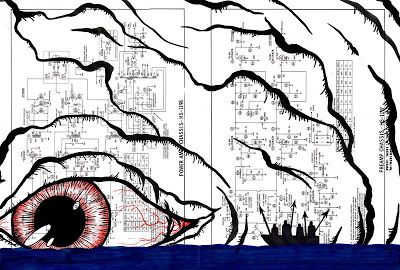
De plus, le très "sédentaire" (au moins saisonnièrement) Timor Tom, ainsi que ses ancêtres, avaient tout loisir d'échanger avec des communautés cétacéennes issues aussi bien des côtes malgaches, voire angolaises, que chiliennes. Citons une fois encore Keen à ce propos :
"Any animal wishing to migrate from the southern oceans to breeding and calving grounds of Polynesia or Japan must navigate Indonesia’s labyrinthine corridors. Indonesia: the equatorial threshold of the Eastern biosphere, the axis mundi of Pacific and Indian life. Like a turnstile, these islands serve to funnel marine mammals through passages that condense their numbers and push them right up to the coast. One such thoroughfare, the Ombai Strait, is located in the eastern portion of the subduction zone where the Australian plate plummets particularly dramatically toward the center of the earth. Its free fall carves out a long and deep oceanic trench, the Timor Trough. The walls of this underwater canyon push abyssal currents and their nutrients toward the surface in a concentrated upwelling, bringing deepwater species bubbling up in tow. The predatory schools of abyssal squid and fish follow the nutrients higher and higher, straying shallower than they should in order to harvest the plankton riding the underwater thermals towards the sun. All this can easily convince whales to take their time as they lumber past the Timor Trough during their traverse through the passages of Indonesia."
Il y a donc eu vraisemblablement plusieurs "Timor Tom" entre 1800 et 1860, tous nommés ainsi tant le premier d'entre eux avait marqué les esprits, comme ce fut le cas un peu plus tard pour Mocha Dick. Sans quoi on aurait vraisemblablement évoqué dans les gaillards d'avant un Celebes Joe, Mollucas Dick, Borneo Jack, Filipino Jim et autres... Il n'est même pas exclu que Melville saluant le combattant "qui si longtemps te cachas dans les detroits..." évoque peut être, sans le savoir, plusieurs individus : Eric Keene ayant démontré le caractère "dynastique" des cachalots blancs du triangle de Corail depuis de nombreux siècles, "Timor Jack" avait certainement pu (après bien d'autres) constituer un véritable "clan blanc" (voir "Ondulation Chromatique" mis en ligne le 11 septembre 2016, pour un phénomène homologue chez des orques épaulards dans le Pacifique Nord de nos jours...). De plus, certains témoignages cités plus haut semblent indiquer la présence de cachalots blancs dans les parages dans un passé qui se compte plus en décennies qu'en siècles...
Voir aussi l'excellent documentaire : Le triangle de Corail. Un foisonnement de vie. Rediffusion samedi 10 juin à 13h30. Excellent documentaire sur les confins indopacifiques de la sonde orientale. Historique, Timor Tom, Lamalera et la représentation des cachalots ancêtres... Baleines bleues et cachalots se repèrent d'après l'activité volcanique, dans une approche très "song line" ...
Voir la video encore pour quelques jours ici.
http://playtv.fr/replay/958651/le-triangle-de-corail-un-foisonnement-de-vie/
Les embarcations des cachalotiers de Lamalera peuvent parfois être entraînées par l'animal qu'ils ont harponné jusqu'à Timor. Deux d'entre elles, le Dato Tena et le Menula Belolong, le furent lors de l'attaque japonaise sur Kupang (Timor occidental), le 20 février 1942 (pages 304 - 305, dans : Sea hunters of Indonesia. Fishers and weavers of Lamalera. R.H. Barnes. Clarendon Press, Oxford. 1996). Ils revinrent à Lamalera, épuisés, trois jours plus tard. Le cachalot avait été dévoré en grande partie par les requins, et ce qui en restait commençait à pourrir. Les requins étaient si nombreux que l'équipage du Dato Tena put en capturer 24 et celui du Menula Belolong, 18...
A 1993 report [related] 34 Lamaralese fishermen being towed out to sea for four days by a big bull sperm whale. Dans "In Search of Moby Dick: The Quest for the White Whale", Tim Severin. Basic Books, 2000.
Dans un mois jour pour jour, il y aura exactement 10 ans qu'un grand cachalot "blanc"( en tout cas sur une partie importante de son côté gauche) a été tué à Lamalera. Il mesurait 18m. C'est probablement l'un des multiples descendants lointains de Timor Tom, [encore plus récent que celui mentionné plus haut, qui fit parler de lui dans la communauté en 1970].
Voir le détail et la photo dans le document accessible ici :
file:///C:/Users/Alain/Downloads/SES84_08.pdf
Le 18 août 2013, 8 membres de la communauté de Lamalera ont disparu après qu'une orque harponnée ait entraîné leur pirogue par le fond. 4 coéquipiers également présents à bord de l'embarcation ont survécu.
https://freedolphinsbelgium.wordpress.com/2013/08/20/une-orque-entraine-8-chasseurs-par-le-fond-en-indonesie/
En Nouvelle Zélande, le plus célèbre accompagnateur de navires fut le dauphin de Russo Pelorus Jack (voir sa page sur Wikipedia).
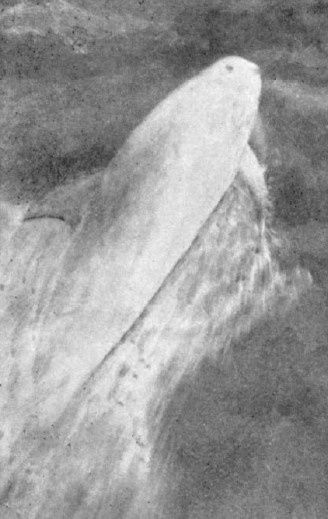
Il fait écho à d'autres animaux de son espèce qui guidaient les pirogues des maoris.
Cowan, James. The Story of Pelorus Jack: The White Dolphin of French Pass, New Zealand, with Maori Legends. 2d ed. Auckland, New Zealand: Whitcombe & Tombs, 1930. 1st ed. Christchurch, New Zealand, 1911. (35-page booklet with photos)
This booklet, first published in 1911, and revised in 1930 by adding some additional facts and some Maori legends about Pelorus Jack (a Risso's dolphin, Grampus griseus), describes the route of travel Jack kept both day and night for twenty years when accompanying coastal steamers and other vessels near French Pass, New Zealand. (Jack never actually entered French Pass, but always stopped just outside the entrance). The booklet includes maps and other illustrations and the Government Order-in-Council protecting all fish [sic] or mammals of Pelorus Jack's species in the waters of Cook Strait.
"Maori folk-lore abounds with references to taniwhas of the deep, sea-deities [who] were originally men, and [who] exercised "benevolent and maleficent powers over humans who ventured out upon the deep . . . Most famous of all these Maori taniwha-fish [sic] . . . was 'Kaikai-a-waro' [lit. 'Food of the Deep'], [who] the pakeha [the white race] called 'Pelorus Jack.' As Triton with his 'wreathed horn' preceded his ocean-riding father Poseidon, so the scythe-finned taniwha of the Maori seas escorted their chiefs' canoes; and so did 'Kaikai-a-waro,' playing swiftly around the bows of the Trans-Cook Strait fire-canoes, as if leading them on their way, a wonder and a delight to thousands of sea-travellers."
The last half of the booklet recounts stories about Kaikai-a-waro told to the author by Kipa Hemi Wharo, who claimed to be Jack's "chief," and who firmly believed that "'Jack' was the incarnation of his ancestors' sea-god." Kipa Hemi Wharo was regarded by all the Sounds Maoris as the leading authority on their ancestral history and whakapapa (genealogical recitals and traditions).
Voir aussi :
- Ross E Hutchins et Jerome P Connolly - La saga de Pelorus Jack (1971)
"FICTION", "REALITE", IMPRUDENTS VOCABLES... Dans le roman de Melville (1851), le Vieux Mâle (Ancêtre massacré) et Moby Dick (Guerrier Vengeur) connaissent des avatars "réels", en Août 1859 pour le premier*, en Juillet 1902 pour le second (un cachalot blanc de 27m sera abattu au canon lance - harpon par un Wampanoag, Amos Smalley, harponneur à bord du baleinier barque Platina, commandé par le capitaine Thomas McKenzie, au large des Açores).
* le "Vieil Adam", grand mâle épuisé par les ans, manchot, aveugle avec disparition complète de la structure oculaire, recouvert de tâches jaunâtres, couvert d'abcès purulents dont l'un provoqué par une pointe de lance en pierre précolombienne, se fait massacrer (dans le chapitre 81) pour un résultat nul... Finalement attaché au navire, le martyr sombre et commence à entraîner celui - ci avec lui. L'équipage doit rompre les liens et laisser s'enfoncer la proie. Le vieil Adam annonce aussi, étrangement, ce vieux mâle blanc cacochyme et agonisant, aussi grand qu'une baleine bleue, édenté et borgne, achevé sans combat au large du Brésil 8 ans APRES la publication de l'ouvrage...
LE SILLAGE DU SERPENT - LUCIOLE. En 1962, le chilien Francisco Coloane évoque, dans "El Camino de la Ballena", un vieux mâle baleine bleue solitaire de 35m de long, capturé inutilement par un baleinier dans l'Antarctique, qui doit finalement renoncer à sa prise pour éviter de sombrer avec elle.
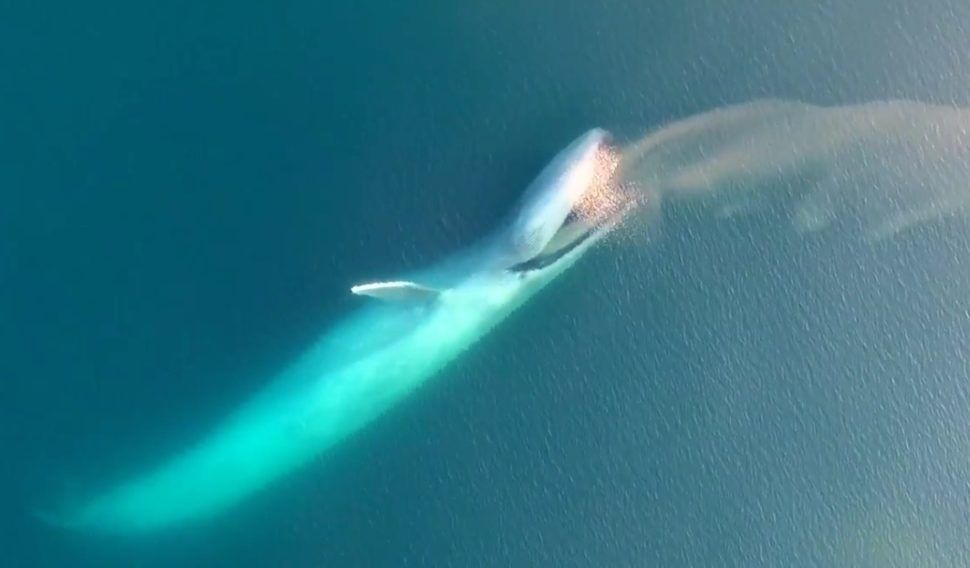
Ceci évoque à la fois 1851 quant à l'issue, et 1859 quant à la taille de l'Animal. Mais il s'agit ici d'un CORPS GLORIEUX (qui fait pendant aux plaintes du baleinier : "Je suis comme ces vieux cachalots qui pourrissent au milieu des glaces...").

Comme le Christ du Retable de Colmar, ou le Saumon qui rajeunit après la ponte, l'Entité apparaît dans toute son étincelante Majesté ; " Soudain, dans ce vaste silence, une masse blanche et bleue creva la surface des eaux, dans un bruit monumental de verre brisé...C'était un mâle d'une taille vraiment colossale, dont la peau couverte par endroits d'une croûte de coquillages et de parasites brillait comme un manteau incrusté de pierreries... Une écume irisée moussait au coin des lippes comme si la bête mâchait un arc - en - ciel". Entité supra - animale et itinéraire temporel incarné, la gigantesque baleine de l'Antarctique est à la fois un authentique serpent arc - en - ciel australien, et une luciole géante japonaise (nous préciserons ce dernier point sur ce blog le 21 juin prochain).
Il apparaît donc que CHAQUE cachalot combattant du XIXème siècle (voir une liste non exhaustive dans "Les vieux soldats ne meurent jamais" mis en ligne le 22 février 2017) ne représente probablement que la tête d'une comète temporelle, corps et queue de celle - ci étant sa dynastie originaire de la nuit des temps. Sur tout l'arc pacifique, chaque communauté humaine a interprété et apprivoisé mentalement sa comète particulière selon ses propres codes et représentations, comme nous l'avons illustré ici à travers quelques exemples du Pacifique occidental. Concernant la partie orientale de celui - ci, celle dont Mocha Dick est la tête, au large du Chili, est enchassée dans la mythologie mapuche du Trempulcahue ou les quatre baleines psychopompes assurent la transmigration des âmes (Amucha)...
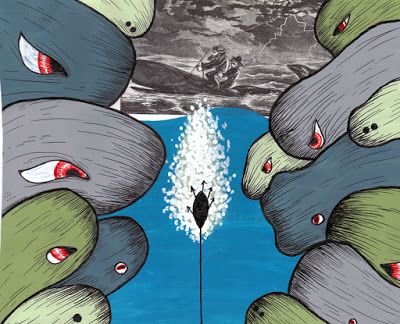
Restent de TRES nombreux îlots indiscernés d'un Archipel inconnaissable, d'une Inflorescence des Vents blottie dans la gueule de l'Eternité... ("Simplement, un coeur qui bat", mis en ligne le 6 juin 2015; "Un roc, un cap", mis en ligne le 6 décembre de la même année; et Jean - François Gautier "Connaissons - nous mieux le présent que le passé?" dans Eléments 165, Avril - Mai 2017, 88 - 90).
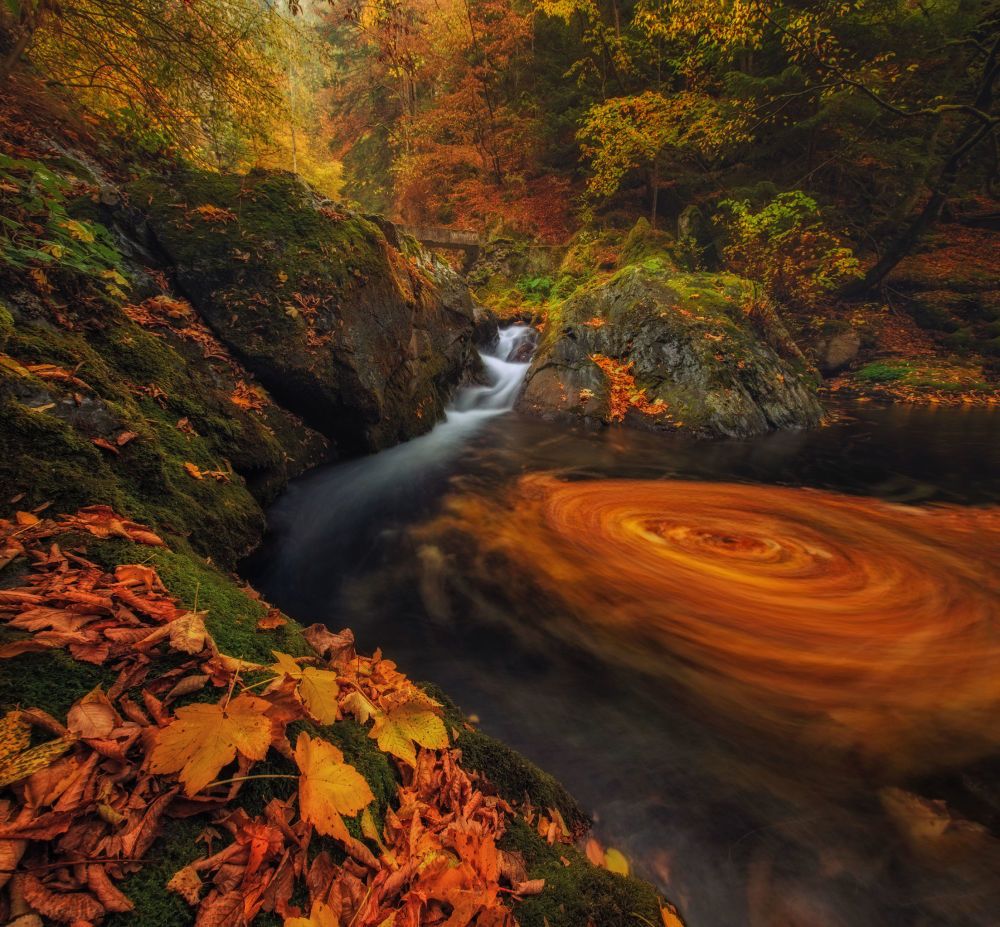
Les MOBY DICK des siècles passés vont être suivis par beaucoup d'autres. Leur Histoire ne fait que commencer. "Léviathan laisse derrière lui un sillage lumineux / L'abîme semble couvert d'une toison blanche". Job 41, 24.


